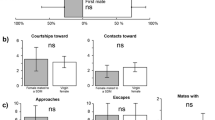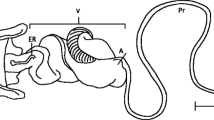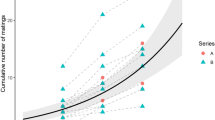Abstract
Multiple mating by females increases both the risk and intensity of sperm competition for males. The ability to temporarily or permanently inhibit female receptivity to further mating represents a highly adaptive strategy to reduce the risk of sperm competition. Males of the West Indian sweet potato weevil Euscepes postfasciatus (Fairmaire) (Coleoptera: Curculionidae) and the seed bug Togo hemipterus (Scott) (Heteroptera: Lygaeidae) use accessory gland substances to inhibit remating in females. It is known that there is variance in the length of the female refractory period (i.e., the effectiveness of male ejaculate substances that inhibit female remating) within a species. However, it is unclear what types of male traits affect the length of the female refractory period. The mechanism of the female refractory period is not sufficiently revealed. We focused on male body size, which is often a target of sexual selection, and investigated the relationship between male body size and both the refractory period of females and mating duration. Contrary to our thought, male body size did not significantly influence the refractory period of females or mating duration in either species. Smaller male body size was not particularly favored by post-copulatory sexual selection in either species.




Similar content being viewed by others
References
Abraham S, Goane L, Cladera J, Vera MT (2011) Effects of male nutrition on sperm storage and remating behavior in wild and laboratory Anastrepha fraterculus (Diptera: Tephritidae) females. J Insect Physiol 57:1501–1509
Aluja M, Rull J, Sivinski J, Trujillo G, Pérez-Staples D (2009) Male and female condition influence mating performance and sexual receptivity in two tropical fruit flies (Diptera: Tephritidae) with contrasting life histories. J Insect Physiol 55:1091–1098
Arnqvist G, Rowe L (2005) Sexual conflict. Princeton University Press, Princeton
Avila FW, Sirot LK, LaFlamme BA, Rubinstein CD, Wolfner MF (2011) Insect seminal fluid proteins: identification and function. Annu Rev Entomol 56:21–40
Bangham J, Chapman T, Partridge L (2002) Effects of body size, accessory gland and testis size on pre- and postcopulatory success in Drosophila melanogaster. Anim Behav 64:915–921
Bissoondath CJ, Wiklund C (1996) Effect of male mating history and body size on ejaculate size and quality in two polyandrous butterflies, Pieris pieris and Pieris rapae (Lepidoptera; Pieridae). Funct Ecol 10:457–464
Carroll KJ (2003) On the use and utility of the Weibull model in the analysis of survival data. Control Clin Trials 24:682–701
Chapman T, Davies SJ (2004) Functions and analysis of the seminal fluid proteins of male Drosophila melanogaster fruit flies. Peptides 25:1477–1490
Chapman T, Miyatake T, Smith H, Partridge L (1998) Interaction of mating, egg production and death rates in females of the Mediterranean fruit fly, Ceratitis capitata. Proc R Soc Lond B 265:1879–1894
Danielsson I (2001) Antagonistic pre- and post-copulatory sexual selection on male body size in a water strider (Gerris lacustris). Proc R Soc Lond B 268:77–481
Evans JP, Zane L, Francescato S, Pilastro A (2003) Directional postcopulatory sexual selection revealed by artificial insemination. Nature 421:360–4363
Gillott C (2003) Male accessory gland secretions: modulators of female reproductive physiology and behavior. Annu Rev Entomol 48:163–184
Haussmann IU, Hemani Y, Wijesekera T, Dauwalder B, Soller M (2013) Multiple pathways mediate the sex-peptide-regulated switch in female reproductive behaviours. Proc R Soc B Biol Sci 280(1771):20131938
Himuro C, Fujisaki K (2008) Males of the seed bug Togo hemipterus (Heteroptera: Lygaeidae) use accessory gland substances to inhibit remating by females. J Insect Physiol 54:1538–1542
Himuro C, Fujisaki K (2010) Mating experience weakens starvation tolerance in the seed bug Togo hemipterus (Heteroptera: Lygaeidae). Physiol Entomol 35:128–133
Himuro C, Fujisaki K (2012) Sexual size dimorphism and aggressive interactions under starvation conditions in the seed bug Togo hemipterus (Heteroptera: Lygaeidae). J Insect Behav 25:242–253
Himuro C, Fujisaki K (2014) Evolutionary causes of male-biased sexual size dimorphism from a female perspective in the seed bug Togo hemipterus (Heteroptera: Lygaeidae). Appl Entomol Zool 49:347–352
Himuro C, Hosokawa T, Suzuki N (2006) Alternative mating strategy of small male Megacopta punctatissima (Hemiptera: Plataspidae) in the presence of large intraspecific males. Ann Entomol Soc Am 99:974–977
Himuro C, Ikegawa Y, Honma A (2017) Males use accessory gland substances to inhibit remating by females in West Indian sweet potato weevil (Coleoptera: Curculionidae). Ann Entomol Soc Am 110:374–380
Hiroyoshi S, Moriya S (1999) Effects of aging and temperature on the male’s reproductive development of the West Indian sweet potato weevil, Euscepes postfasciatus (Fairmaire) (Coleoptera: Curculionidae). Entomol Sci 2:165–171
Hosken DJ, Stockley P (2003) Benefits of polyandry: a life history perspective. J Evol Biol 33:173–194
Jang EB (1995) Effects of mating and accessory gland injections on olfactory-mediated behavior in the female Mediterranean fruit fly, Ceratitis capitate. J Insect Physiol 41:705–710
Kohama T, Shimoji Y (1998) Reproductive maturity of the female West Indian sweet potato weevil, Euscepes postfasciatus (Fairmaire) (Coleoptera: Curculionidae). Appl Entomol Zool 33:1–4
Kohama T, Sugiyama M (2000) External characteristics for sexing the West Indian sweet potato weevil, Euscepes postfasciatus (Fairmaire) (Coleoptera: Curculionidae). Entomol Sci 3:43–46
Koyama J, Kakinohana H, Miyatake T (2004) Eradication of the melon fly, Bactrocera cucurbitae, in Japan: importance of behavior, ecology, genetics, and evolution. Ann Rev Entomol 49:311–349
Kuba H, Kohama T, Haraguchi D (2003) Eradication projects of exotic sweet potato weevils using SIT in Okinawa. In: Oka M, Matsui M, Shiomi T, Ogawa Y, Tsuchiya K (eds) Proceedings of the NIAES-FFTC Joint International Seminar on Biological Invasions: Environmental impacts and the development of a database for the Asian-Pacific Region. National Institute for Agro-Environmental Sciences & Food and Fertilizer Technology Center for the Asian and Pacific Region, Tsukuba, pp 273–287
Kumano N (2014) Recent advances in the study on sterile technique for the West Indian sweet potato weevil, Euscepes postfasciatus. Jpn J Appl Entomol Zool 58:217–236 (in Japanese)
Kumano N, Kuriwada T, Shiromoto K, Haraguchi D, Kohama T (2010) Effect of body size and sex ratio on male alternative mating tactics of the West Indian sweet potato weevil, Euscepes postfasciatus. Entomol Exp Appl 135:154–161
LaMunyon CW, Eisner T (1993) Spermatophore size as determinant of paternity in an arctiid moth (Utetheisa ornatrix). Proc Natl Acad Sci USA 91:7081–7084
Lance DR, McInnis DO (2005) Biological basis of the sterile insect technique. In: Dyck VA, Hendrichs J, Robinson AS (eds) Sterile insect technique: principles and practice in area-wide integrated pest management. Springer, Dordrecht, pp 69–94
Lewis SM, Austad SN (1990) Sources of intraspecific variation in sperm precedence in red flour beetles. Am Nat 135:351–359
Lewis SM, Austad SN (1994) Sexual selection in flour beetles: the relationship between sperm precedence and male olfactory attractiveness. Behav Ecol 5:219–224
Locatello L, Rasotto MB, Adriaenssens B, Pilastro A (2008) Ejaculate traits in relation to male body size in the eastern mosquitofish Gambusia holbrooki. J Fish Biol 73:1600–1611
Mautz BS, Møller AP, Jennions MD (2013) Do male secondary sexual characters signal ejaculate quality? A meta-analysis. Biol Rev 88:669–682
McLain DK (1985) Male size, sperm competition, and the intensity of sexual selection in the southern green stink bug, Nezara viridula (Hemiptera: Pentatomidae). Ann Entomol Soc Am 78:86–89
McLain DK (1991) Heritability of size: a positive correlate of multiple fitness components in the southern green stink bug (Hemiptera: Pentatomidae). Ann Entomol Soc Am 84:174–178
Miyatake T, Matsumura F (2004) Intra-specific variation in female remating in Callosobruchus chinensis and C. maculatus. J Insect Physiol 50:403–408
Miyatake T, Chapman T, Partridge L (1999) Mating-induced inhibition of remating in female Mediterranean fruit flies Ceratitis capitata. J Insect Physiol 45:1021–1028
Mossinson S, Yuval B (2003) Regulation of sexual receptivity of female Mediterranean fruit flies: old hypotheses revisited and a new synthesis proposed. J Insect Physiol 49:561–567
O’Dea RE, Jennions MD, Head ML (2014) Male body size and condition affects sperm number and production rates in mosquitofish, Gambusia holbrooki. J Evol Biol 27:2739–2744
Okinawa Prefectural Plant Protection Center (2005) Project report on control of special diseases and insect pests in Okinawa Prefecture 2004, vol 30, pp 156–157 (in Japanese)
Otronen M (1984a) The effect of differences in body size on the male territorial system of the fly Dryomyza anilis. Anim Behav 32:882–890
Otronen M (1984b) Male contests for territories and females in the fly Dryomyza anilis. Anim Behav 32:891–898
Otronen M (1994) Fertilization success in the fly Dryomyza anilis (Dryomyzidae): effects of male size and the mating situation. Behav Ecol Sociobiol 35:33–38
R Development Core Team (2016) R: a language and environment for statistical computing. R Foundation for Statistical Computing, Vienna
Ritz C, Baty F, Streibig JC, Gerhard D, Baun A, Nyholm N (2015) Dose-response analysis using R. PLoS ONE 10:e0146021
Rubolini D, Galeotti P, Ferrari G, Spairani M, Bernini F, Fasola M (2006) Sperm allocation in relation to male traits, female size, and copulation behaviour in a freshwater crayfish species. Behav Ecol Sociobiol 60:212–219
Sato Y, Kohama T (2007) Post-copulatory mounting behavior of the West Indian sweetpotato weevil, Euscepes postfasciatus (Fairmaire) (Coleoptera: Curculionidae). Ethology 113:183–189
Shimizu T, Moriya S (1996) Tracking the adult loco- motion in the West Indian sweetpotato weevil, Euscepes postfasciatus (Fairmaire) (Coleoptera: Curculionidae). Appl Entomol Zool 31:181–184
Simmons LW (2001) Sperm competition and its evolutionary consequences in the insects. Princeton University Press, Princeton
Simmons LW, Gwynne DT (1991) The refractory period of female katydids (Orthoptera: Tettigoniiidae): sexual conflict over the remating interval? Behav Ecol 2:267–282
Simmons LW, Lüpold S, Fitzpatrick L (2017) Evolutionary trade-off between secondary sexual traits and ejaculates. Trends Ecol Evol 32:964–976
Sirot LK, Wong A, Chapman T, Wolfner MF (2015) Sexual conflict and seminal fluid proteins: a dynamic landscape of sexual interactions. Cold Spring Harb Perspect Biol 7:a017533
Wedell N (1993) Spermatophore size in bushcrickets: comparative evidence for nuptial gifts as a sperm competition device. Evolution 47:1203–1212
Wedell N, Cook PA (1999) Butterflies tailor their ejaculate in response to sperm competition risk and intensity. Proc R Soc Lond B 266:1033–1039
Zhu HP, Xia X, Yu CH, Adnan A, Liu SF, Du YK (2011) Application of Weibull model for survival of patients with gastric cancer. BMC Gastroenterol 11:1
Acknowledgements
We thank Mr. Satoshi Kinjo, Ms. Rimi Miyagi, Mr. Kazuya Uehara, Mr. Hiraku Nakazato, Mr. Riki Yamaneko, Ms. Midori, Ms. Toyoko Izumi, and Mr. Tetsuzo Shimoji for their help with conducting some of our experiments. We also thank members of the Okinawa Prefectural Plant Protection Center and Ryukyu Sankei Co. Ltd. for their assistance with this study. This work was supported in part by a Grant-in-Aid for JSPS Fellows (No. 24-4740) and a Grant‐in‐Aid for Scientific Research (C) (No. 18K05667 to C.H.) from the Japan Society for the Promotion of Science. The experiments conducted in this study comply with the current laws of Japan.
Author information
Authors and Affiliations
Contributions
All authors contributed to the study conception and design. Material preparation, data collection and analysis were performed by CH, AH, YI and TO. The first draft of the manuscript was written by CH and all authors commented on previous versions of the manuscript. All authors read and approved the final manuscript.
Corresponding author
Additional information
Publisher's Note
Springer Nature remains neutral with regard to jurisdictional claims in published maps and institutional affiliations.
About this article
Cite this article
Himuro, C., Honma, A., Ikegawa, Y. et al. Male body size does not affect the refractory period of females in the West Indian sweet potato weevil Euscepes postfasciatus (Fairmaire) (Coleoptera: Curculionidae) and the seed bug Togo hemipterus (Scott) (Heteroptera: Lygaeidae). J Ethol 39, 39–46 (2021). https://doi.org/10.1007/s10164-020-00669-9
Received:
Accepted:
Published:
Issue Date:
DOI: https://doi.org/10.1007/s10164-020-00669-9




